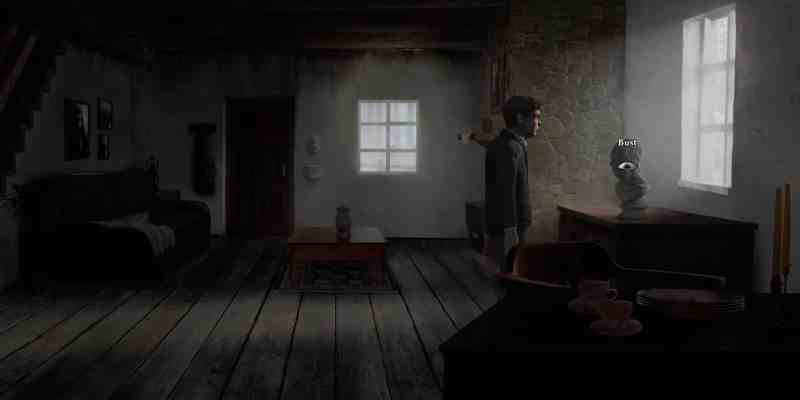By nature, non-playable characters in adventure games tend to be a helpful bunch. A stranger in the midst of a new town is often regaled with tales of the town’s history, pleas for help with everyday issues, and gentle pushes in the right direction to continue the plot. In contrast, the suspicious inhabitants of Sveti Kotar are extremely displeased by the protagonist of Saint Kotar: The Yellow Mask, Benedek, appearing on their doorstep. Few residents will open their door to him, and fewer still are willing to talk to him about his missing sister. Fighting through the people’s mistrust, Benedek’s anxiety, and the menacing presence of the town itself makes this an unusual adventure game indeed.
Benedek Dohnany regretted moving to Sveti Kotar from the moment he arrived. A deeply pious man, the strange behavior of the locals and arcane sculptures upon the walls fill him with a sense of dread. Haunted by nightmares of being trapped in purgatory where he is accused of committing a terrible sin, Benedek plans to leave the town, blaming its strange nature for his terrible visions.
However, he cannot leave without his sister Viktoria, and when he finally awakens from his horrific dream, she is nowhere to be found. Her husband, Nikolay, is also concerned about her disappearance, a worry sharpened by the fact the house was robbed the same night. Initially blaming each other for Viktoria’s absence, the two men reluctantly work together to search the town for clues, getting drawn into a deeper mystery of strange rituals and vanishing memories.
While Saint Kotar: The Yellow Mask follows the principles of a point-and-click adventure, with collecting items, examining the environment, and interrogating people the key to progression, a lot more emphasis is put on following the story than solving puzzles. Yelling at Nikolay for being a bad influence on his sister is just as important to Benedek as hunting through the house for his beloved Bible. The townspeople who are willing to talk have full-blown conversations with the protagonists, talking about their own interests along with hints on where Viktoria might have gone. A few sections do require using the right item in the right place, but most of the time Benedek and Nikolay will be carefully listening to what they are told.
The chatty nature of the game works well to fully develop the characters of Benedek, Nikolay, and the townspeople, all of whom are flawed in one way or another. Benedek is highly anxious, refusing to give his name to a shopkeeper that recognizes his face and constantly seeking reassurance from God that his nightmare was just a dream. Nikolay approaches the world with a cold anger, ready to lash out at a man he has convinced himself is the robber, despite the evidence for the crime being awfully tenuous. The locals themselves are unhelpful at best, unwilling to talk about the events the night Viktoria disappeared since it occurred during the sacred town festival. An air of suspicion hangs over every encounter, creating an unsettling atmosphere.

The creepiness of Saint Kotar: The Yellow Mask is aided by excellent voice acting, with every line in the prologue voiced. The performances are a touch melodramatic — Benedek is near shrieking with fear in his dream, and Nikolay is constantly simmering with rage — but this intensity works for the tale the game is telling. High emotions give credence to Benedek’s theory that the town is cursing them and raise the stakes for every conversation.
Sveti Kotar would have been a magnificent town, once, but it has long since fallen into disrepair, with crumbling cobblestone and mouldy window fittings. The 2.5D camera is put to great use, providing a good view of each room while still being easy to navigate. A lot of attention has been given to the little details: a wavy red filter over Benedek’s dream sequence, the intricate masks in the shopkeeper’s stall, and the horrific present of a pig’s bowel filled with eyes left at the time of the robbery. Gory details are used sparingly, making them all the more effective when they do appear.
While the in-game graphics are excellent, the user interface could use more polish. The subtitles are a bit small and sometimes hard to read, especially when Benedek’s brown text is over a brown path. The button to highlight interactable elements lags for a second or two, and the icons used are distractingly ugly, dotting the screen with bright eye-shaped sprites. Outlining usable spots, or perhaps adding glowing dots, would still aid the player without marring the artwork.

Saint Kotar: The Yellow Mask is about two-to-three hours long, just long enough to get a taste of what is planned ahead. I would have liked to see a more obvious story branch in this section: I think how well Benedek and Nikolay get along is determined by choices in this chapter, but otherwise events are not affected. Larger story branches are reportedly planned for the full release, which is aiming for a length of 20 hours. As it is, however, the game builds a strong foundation for an extremely creepy mystery. Developer Red Martyr Entertainment is seeking funding on Kickstarter to complete the story, and I hope the project reaches its target.
Next week we will be playing The Night Fisherman, an interactive text game about a wayward encounter with a smuggler. The game can be downloaded from Steam. If you would like to share your thoughts, discussions will be happening on the Discord server.
